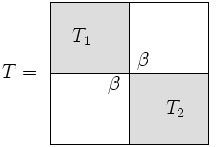 | ||
Divide-and-conquer eigenvalue algorithms are a class of eigenvalue algorithms for Hermitian or real symmetric matrices that have recently (circa 1990s) become competitive in terms of stability and efficiency with more traditional algorithms such as the QR algorithm. The basic concept behind these algorithms is the divide-and-conquer approach from computer science. An eigenvalue problem is divided into two problems of roughly half the size, each of these are solved recursively, and the eigenvalues of the original problem are computed from the results of these smaller problems.
Contents
Here we present the simplest version of a divide-and-conquer algorithm, similar to the one originally proposed by Cuppen in 1981. Many details that lie outside the scope of this article will be omitted; however, without considering these details, the algorithm is not fully stable.
Background
As with most eigenvalue algorithms for Hermitian matrices, divide-and-conquer begins with a reduction to tridiagonal form. For an
In certain cases, it is possible to deflate an eigenvalue problem into smaller problems. Consider a block diagonal matrix
The eigenvalues and eigenvectors of
For the rest of this article, we will assume the input to the divide-and-conquer algorithm is an
Divide
The divide part of the divide-and-conquer algorithm comes from the realization that a tridiagonal matrix is "almost" block diagonal.
The size of submatrix
We write
The only difference between
The remainder of the divide step is to solve for the eigenvalues (and if desired the eigenvectors) of
Conquer
The conquer part of the algorithm is the unintuitive part. Given the diagonalizations of the submatrices, calculated above, how do we find the diagonalization of the original matrix?
First, define
The remaining task has been reduced to finding the eigenvalues of a diagonal matrix plus a rank-one correction. Before showing how to do this, let us simplify the notation. We are looking for the eigenvalues of the matrix
If wi is zero, (
If
where
Keep in mind that
or written as a scalar equation,
This equation is known as the secular equation. The problem has therefore been reduced to finding the roots of the rational function defined by the left-hand side of this equation.
All general eigenvalue algorithms must be iterative, and the divide-and-conquer algorithm is no different. Solving the nonlinear secular equation requires an iterative technique, such as the Newton–Raphson method. However, each root can be found in O(1) iterations, each of which requires
Analysis
As is common for divide and conquer algorithms, we will use the Master theorem to analyze the running time. Remember that above we stated we choose
In the notation of the Master theorem,
Remember that above we pointed out that reducing a Hermitian matrix to tridiagonal form takes
The advantage of divide-and-conquer comes when eigenvectors are needed as well. If this is the case, reduction to tridiagonal form takes
Practical use of the divide-and-conquer algorithm has shown that in most realistic eigenvalue problems, the algorithm actually does better than this. The reason is that very often the matrices
Variants and implementation
The algorithm presented here is the simplest version. In many practical implementations, more complicated rank-1 corrections are used to guarantee stability; some variants even use rank-2 corrections.
There exist specialized root-finding techniques for rational functions that may do better than the Newton-Raphson method in terms of both performance and stability. These can be used to improve the iterative part of the divide-and-conquer algorithm.
The divide-and-conquer algorithm is readily parallelized, and linear algebra computing packages such as LAPACK contain high-quality parallel implementations.
